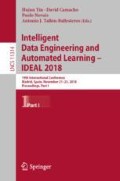Abstract
Neuroevolution is a technique that has been successfully applied for over three decades in order to optimize certain aspects of neural networks by applying evolutionary algorithms. However, only in the recent years, the increase of computational resources has enabled to apply such techniques to deep and convolutional neural networks, where the number of hyperparameters is significantly large.
In recent years, deep and convolutional neural networks are outperforming classical machine learning for many different tasks, including computer vision, natural language processing, signal processing, activity recognition, etc. In this context, neuroevolution can be useful since there are no analytic approaches for determining optimal network architectures or hyperparameters, therefore attaining better performance. Moreover, in some cases, committees (also called ensembles) are used, which combine two or more models in order to improve results even more. Neuroevolution can be of particular importance in this case, since evolutionary algorithms evolve a whole population of individuals, making it easy to build ensembles out of models chosen among those in the evolved population.
In this paper, we explore the application of genetic algorithms for carrying out model selection in a context of neuroevolution. Thus, the best models will be selected from a population of evolved individuals in order to maximize an overall objective function. This approach is tested using the well-known MNIST database as benchmark, and it obtains results which are highly competitive when compared with the state of the art.
Access this chapter
Tax calculation will be finalised at checkout
Purchases are for personal use only
References
Akhtyamova, L., Ignatov, A., Cardiff, J.: A Large-scale CNN ensemble for medication safety analysis. In: Frasincar, F., Ittoo, A., Nguyen, L.M., Métais, E. (eds.) NLDB 2017. LNCS, vol. 10260, pp. 247–253. Springer, Cham (2017). https://doi.org/10.1007/978-3-319-59569-6_29
Baker, B., Gupta, O., Naik, N., Raskar, R.: Designing neural network architectures using reinforcement learning. In: Proceedings of the 5th International Conference on the Learning Repr. (2017)
Baldominos, A., Saez, Y., Isasi, P.: Evolutionary convolutional neural networks: an application to handwriting recognition. Neurocomputing 283, 38–52 (2018)
Baldominos, A., Saez, Y., Isasi, P.: Evolutionary design of convolutional neural networks for human activity recognition in sensor-rich environments. Sensors 18(4), 1288 (2018)
Breiman, L.: Random forests. Mach. Learn. 45(1), 5–32 (2001)
Chang, J.R., Chen, Y.S.: Batch-normalized maxout network in network. arXiv arXiv:1511.02583 (2015)
Ciresan, D.C., Meier, U., Gambardella, L.M., Schmidhuber, J.: Convolutional neural network committees for handwritten character classification. In: Proceedings of the 2011 International Conference on Document Analysis and Recognition, pp. 1135–1139 (2011)
Davison, J.: DEvol: Automated deep neural network design via genetic programming (2017). https://github.com/joeddav/devol. Accessed 01 July 2017
Desell, T.: Large scale evolution of convolutional neural networks using volunteer computing. In: Proceedings 2017 Genetic Evolutionary Computation Conference Companion, pp. 127–128 (2017)
Fernando, C., et al.: Convolution by evolution: differentiable pattern producing networks. In: Proceedings 2016 Genetic Evolutionary Computation Conference, pp. 109–116 (2016)
Geurts, P., Ernst, D., Wehenkel, L.: Extremely randomized trees. Mach. Learn. 63(1), 3–42 (2006)
Hinton, G., Srivastava, N., Swersky, K.: RMSProp: divide the gradient by a running average of its recent magnitude. Neural networks for machine learning, Coursera lecture 6e (2012)
Kassahun, Y., Sommer, G.: Efficient reinforcement learning through evolutionary acquisition of neural topologies. In: Proceedings of the 2005 European Symposium on Artificial Neural Networks, pp. 259–266 (2005)
Kingma, D.P., Ba, J.: Adam: a method for stochastic optimization. arXiv arXiv:1412.6980 (2014)
Koutník, J., Schmidhuber, J., Gomez, F.: Evolving deep unsupervised convolutional networks for vision-based reinforcement learning. In: Proceedings 2014 Annual Conference on Genetic and Evolutionary Computation, pp. 541–548 (2014)
Loshchilov, I., Hutter, F.: CMA-ES for hyperparameter optimization of deep neural networks. arXiv abs/1604.07269 (2016)
Miikkulainen, R., et al.: Evolving deep neural networks. arXiv abs/1703.00548 (2017)
Ordóñez, F.J., Roggen, D.: Deep convolutional and LSTM recurrent neural networks for multimodal wearable activity recognition. Sensors 16(1), 115 (2016)
Real, E., et al.: Large-scale evolution of image classifiers. arXiv abs/1703.01041 (2017)
Stanley, K.O., Miikkulainen, R.: Evolving neural networks through augmenting topologies. Evol. Comput. 10(2), 99–127 (2002)
Suganuma, M., Shirakawa, S., Nagao, T.: A genetic programming approach to designing convolutional neural network architectures. In: Proceedings 2017 Genetic Genetic and Evolutionary Computation Conference, pp. 497–504 (2017)
Sultana, J., Rani, M.U., Farquad, M.: An extensive survey on some deep learning applications. In: Proceedings of the 2018 IADS International Conference on Computing, Communications & Data Engineering (2018)
Verbancsics, P., Harguess, J.: Image classification using generative neuroevolution for deep learning. In: Proceedings 2015 IEEE Winter Conference on Applications of Computer Vision, pp. 488–493 (2015)
Voulodimos, A., Doulamis, N., Doulamis, A., Protopapadakis, E.: Deep learning for computer vision: a brief review. Comput. Intell. Neurosci. 2018, 13 (2018)
Xie, L., Yuille, A.: Genetic CNN. arXiv abs/1703.01513 (2017)
Yao, X., Liu, Y.: A new evolutionary system for evolving artificial neural networks. IEEE Trans. Neural Netw. 8(3), 694–713 (1997)
Young, S.R., Rose, D.C., Karnowsky, T.P., Lim, S.H., Patton, R.M.: Optimizing deep learning hyper-parameters through an evolutionary algorithm. In: Proceedings Workshop on Machine Learning in High-Performance Computing Environments (2015)
Zhang, L., Wang, S., Liu, B.: Deep learning for sentiment analysis: a survey. Interdiscip. Rev. Data Min. Knowl. Discov. 8, e1253 (2018)
Zhang, Q., Yang, L.T., Chen, Z., Li, P.: A survey on deep learning for big data. Inf. Fusion 42, 146–157 (2018)
Acknowledgement
This research is supported by the Spanish Ministry of Education, Culture and Sport through FPU fellowship with identifier FPU13/03917.
Author information
Authors and Affiliations
Corresponding author
Editor information
Editors and Affiliations
Rights and permissions
Copyright information
© 2018 Springer Nature Switzerland AG
About this paper
Cite this paper
Baldominos, A., Saez, Y., Isasi, P. (2018). Model Selection in Committees of Evolved Convolutional Neural Networks Using Genetic Algorithms. In: Yin, H., Camacho, D., Novais, P., Tallón-Ballesteros, A. (eds) Intelligent Data Engineering and Automated Learning – IDEAL 2018. IDEAL 2018. Lecture Notes in Computer Science(), vol 11314. Springer, Cham. https://doi.org/10.1007/978-3-030-03493-1_39
Download citation
DOI: https://doi.org/10.1007/978-3-030-03493-1_39
Published:
Publisher Name: Springer, Cham
Print ISBN: 978-3-030-03492-4
Online ISBN: 978-3-030-03493-1
eBook Packages: Computer ScienceComputer Science (R0)

